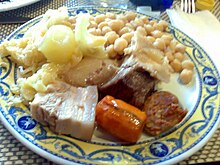Cocido madrileño
The Cocido madrileño ("stew from Madrid") is a traditional chickpea stew from the Spanish capital Madrid . Prepared from vegetables, potatoes and meat, it forms a hearty and rich meal that is particularly popular in winter, although it can be found on the menus in restaurants all year round.
history
The origins of the dish are not known for certain, but most sources agree that it probably evolved from the Sephardic dish Adafina during the Middle Ages . At that time, dishes that were cooked for a long time were indispensable for the Jews , as they could then be eaten as a hearty meal during the Sabbath . Early versions of the stew were kosher and made from eggs and did not contain pork , but over time Adafina became popular elsewhere.
With increasing anti-Semitism and the Spanish Inquisition in the 15th and 16th centuries, the court changed significantly. For fear of being denounced as a Jewish pseudo-Christian and “ Marrano ” (converted Jew) and to prove that one had actually become a Christian , pork was increasingly included in meals. Pork lard , chorizo (Spanish paprika sausage) and morcilla ( blood sausage ) were soon added to the dish.
From then on, the recipe was little further developed and soon established itself as a staple in Madrilean cuisine. As the city expanded in the 19th and 20th centuries, this inexpensive, yet nutritious dish was especially popular among artisans in small restaurants and taverns. After the Civil War , during which much was lacking, the stew lost its popularity in favor of more convenient meals.
Nowadays, cocido madrileño is mostly a homemade dish for special occasions. Even so, most Madrid restaurants have a version of this stew on their menu of the day (especially on Thursdays) and some traditional restaurants even serve it as a specialty on a daily basis.
ingredients
The main ingredient in cocido is chickpeas or garbanzo beans, especially the larger variety (also known as kabuli ). Then various vegetables are added: mainly potatoes , but also white cabbage , carrots and beets . In some cases, green beans , Swiss chard, and cardoon are also added.
Parts of the pig are generally used as meat: pork belly , usually fresh, sometimes also cured (purists even insist that it should be almost rancid); fresh (unsmoked) chorizo; Onion - Morcilla and dried and cured Serrano ham . Beef leg is also added, the more fatty the more valuable. Chicken (especially old hens) is also an ingredient in cocido.
To enrich the broth , two types of bones (pork thigh bones and beef marrow bones ) are added.
Finally, bola , Spanish meatballs made from minced meat , breadcrumbs, parsley and other spices are added to the stew to replace the eggs found in the Adafina.
At the table
Tradition has it that the ingredients of the Cocido are served separately. Each course is called a vuelco ( flap ), as each time you serve it, you have to turn the pot to separate the ingredients.
The first vuelco is the soup : the cocido broth is poured off and pasta is cooked in it. The second vuelco consists of the chickpeas and the vegetables. In the third vuelco , the meat is finally served.
Various other dishes can be prepared in Spanish cuisine from the remains of a cocido . Spanish croquettes are usually prepared with the cocido broth as a condiment. Ropa vieja is a fried mix of meat and chickpeas, and pringá is also made from the remains of the fried meat with bread.

